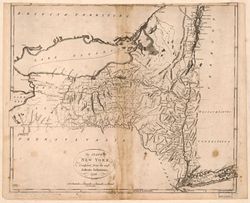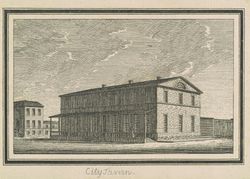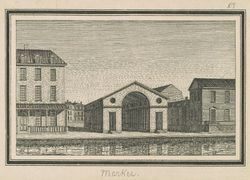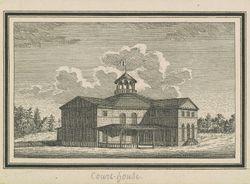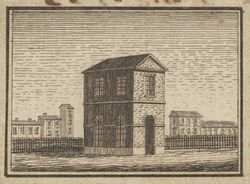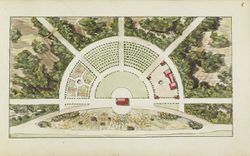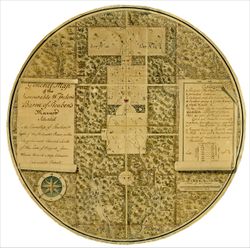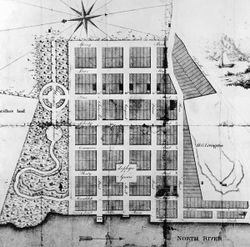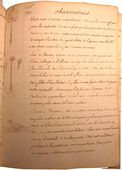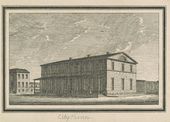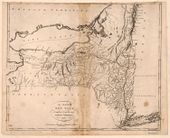Pierre Pharoux
Overview
Birth Date: 1759?
Death Date: September 20, 1795
Role: Architect, Engineer
Used Keywords: Basin, Bridge, Canal, Cascade/Cataract/Waterfall, English style, French style, Greenhouse, Hedge, Meadow, Orchard, Park, Picturesque, Pond, Square, Statue, Sundial, View/Vista, Walk
Other resources: Library of Congress Authority File; Getty ULAN;
Étienne-Pierre Pharoux (1759? – September 20, 1795)[1] was a French architect, a trained-engineer, and a shareholder and agent of La Compagnie de New York (the New York Company), a Paris-based land enterprise that in the 1790s launched a speculative endeavor to settle more than two hundred thousand acres of land in a northwestern region of New York State, named Castorland. His experience in America is known through a few executed works, a journal and a series of visionary architectural and town planning designs that document Pharoux’s response to the urban landscape and the natural environment he encountered.
History
In summer 1794, Étienne-Pierre Pharoux started a survey to acquire proper knowledge of Castorland, today Lewis and Jefferson Counties. [Fig. 1] His journal of the voyage, written in French and compiled for the most part with his compatriot, Simon Desjardins, became an important testimony of post-revolution American history and culture. Often mentioned as the mentor of notorious engineer Marc Isambard Brunel (1769-1849),[2] Pharoux left his own significant mark on American architecture by responding to the urban landscape and to natural environment he encountered with a series of visionary designs and ambitious plans. His architectural vocabulary featuring a neoclassical style ingrained in French Enlightenment, secured him prominent clients such as U.S. Senator from New York Philip Schuyler—father-in-law of Alexander Hamilton—and the Livingston family.[3]
Little is known about Pharoux's life before boarding for New York in 1793. In the years immediately after the French Revolution (1789), he was a member of the Bataillon de Volontaires Bonne-Nouvelle (1791) and one of the sixteen “électeurs” of the Bonne-Nouvelle section of the Electoral Assemblies in the 2nd arrondissement of Paris (1790-1792).[4] Both Pharoux and Desjardins, the other commissioner of La Compagnie in charge of Castorland, were marked as "expert bourgeois" –trained surveyors– in an architect listing of the time. The record further documents their address, respectively Rue de Cléry n.15 and Rue du Porte-Foin n.15. It appears as Pharoux had begun to work as surveyor in 1789, while Desjardins is listed as practicing since 1782.[5] However, Pharoux is noted as "architecte à Paris" in notary records starting in April 1785.[6]
As he reported in his journal, Pharoux and Desjardins arrived in New York City from France on a late summer night in September 1793. After a few days, they managed to meet with their American associates and, presented with fewer details about the purchased land than expected, they departed promptly for the first of several inland expeditions in the northwestern frontiers of New York State. They were joined by Marc Isambard Brunel who they had met on the ship from France.[7] Most of Desjardins’ cargo, which included nearly two thousand volumes, furniture, plant seeds, and several cases of wine, was seized, and then recovered with the exception of a few bottles of wine that remained with the custom clerks.[8]
The documentation of their journey includes descriptions of them traveling the shores of the Black River, the Hudson and Mohawk rivers, where they met with other land speculators, settlers, and members of the Native American tribes such as the Iroquois, the Mississauga, and the Oneida.[9] The journal also narrates their trips to New York and Philadelphia, where they visited the home of John Bartram on the Schuylkill River (view text), and includes notes on their meetings with Alexander Hamilton and Thomas Jefferson.[10] While visiting Philadelphia, Pharoux expressed his distaste of the uniformity of the architecture there. He suggested greater diversity in the cityscape, an approach which would emerge in his own architectural plans. (view text) [Fig. 2]
The original journal in French was re-discovered decades later by historian Franklin Benjamin Hough (1822-1885), and remains in the collections of the Massachusetts Historical Society.[11] Hough first described his findings in the History of Lewis County in 1883, and meant to publish his English translation soon after, but his work was left incomplete. In 1985, historian Edith Pilcher finally published Pharoux and Desjardin’s account for the first time, based on Hough’s translations.[11]
Compiled two years earlier than the renown journals by Benjamin Henry Latrobe about American architecture and landscape, Castorland Journal is more than an historic record of the two Frenchmen’s voyage across the North East. From a linguistic point of view, translator John Gallucci—who re-published the manuscript in 2010 with a new translation directly from the French original—has described how increasingly, as time passed, both English and French words were used to chronicle the surroundings, revealing the "process of acculturation" of its authors "between two linguistic and cultural worlds."[12] Words such as “surveyor, fieldbook, fence, acre, Yankee” were eventually added along with neologisms such as “fencer” to indicate “to fence in.” [12]

What emerged from their accounts was that, contrary to their expectations, Pharoux and Desjardins encountered a number of significant hardship and obstacles as they surveyed the northern territories. When they first travelled to Albany, they could not move further via land as "there being no road opened for more than thirty miles." The area was in the proximity of Fort Oswego and it was "held by the English at the mouth of the Onnondago," they wrote, and then added “as we were French, it was to be feared that they would not let us through and might even take us prisoner."[13] Despite improvements in the navigation and canals as a consequence of the works led by The Western Inland Lock Navigation Company, traveling in the region remained difficult at least through 1803.[14] Nonetheless, the landscape provided some solace and relief to the two commissioners (view text) who found themselves in contemplation of astonishing vistas throughout their voyage (view text). In addition, once their garden was finally established at Castorland [Fig. 3] they were able to put to use the two hundred plant seeds Desjardin had brought over from France and shared with the Baron Von Steuben with whom they had soon become friends, for his property was somewhat close to Castorland. (view text)
La Compagnie de New York was created in Paris in 1793 with the intent to invest in lands in northern and northwestern New York (view text). Those territories had been purchased from New York State in 1791 by a single individual, merchant Alexander Macomb (1748-1831).[15] The northwestern region had remained surprisingly unknown to Europeans despite several accounts by explorers and writers of New Amsterdam, New France, and New York.[16] Because the land was teeming with beavers (castor in both French and Latin), it became known as Castorland.[17]
Following the turmoil and instability of the French political scenario at the time, the Macomb’s Purchase became particularly relevant to investors willing to sell the land to those interested in leaving France. There, two prominent French-Americans were directly involved in promoting the sales: former French consul in New York James Hector St. John de Crèvecoeur (1735–1813), author of Letters from an American Farmer (1782), and James Donatien Le Ray de Chaumont (1760-1841), whose father Jacques, among other things, had served as Benjamin Franklin’s host in France.[18] Ventures such as the one launched by La Compagnie de New York were common. Land speculators in the region abounded as the Hudson River was an important waterway for commerce that had attracted the interest of international traders long before the arrival of Pharoux.[19]
Before Pharoux and Desjardins embarked on the exploration, La Compagnie de New York did not own a topographic map of the northwestern lands to show to investors. William Constable, Macomb’s representative in Europe, was using a map by Claude Joseph Sauthier (1736-1802) from 1779, [Fig. 4] on which Constable had wrongly marked the course of the Black River, which constituted the southern border of Castorland.[20] Pharoux and Desjardins soon discovered that "the actual boundaries as measured on the ground resulted in a significant detriment to the New York Company."[21] In addition, agreements with Native Americans concerning the title of the land as stated in the Company’s Prospectus were uncertain.[22] The Black River became a major matter of contention due to Constable’s misguidance, as well as to the British garrison on the area near Lake Ontario and played a crucial role in the expedition of the two Frenchmen. Tragically, Pharoux drowned in its waters on September 20, 1795.[23]
Ultimately, the venture of La Compagnie de New York failed. The enterprise finally dissolved in 1814. Although, in their journal Pharoux and Desjardins reported several settlements in the Northwestern region of New York State, the area did not develop the way they envisioned. After Pharoux’s tragic death, Desjardins completed the survey, but was eventually removed from his post. Those lands later were subject to further business dealing by James Le Ray de Chaumont and his son Vincent.[24]
In the two years spent in North America, Pharoux became a prominent figure in the Hudson region holding soirees that made local squires "rush to his doors."[25] Along with the Castorland Journal, the French designer legacy includes a fifty-nine page architectural sketchbook, resurfaced in 1991, in which he rendered plans for potential clients. Historian Roger Kennedy has defined it as "the most important book of architectural drawings to be created in the Western Hemisphere before the advent of the nineteenth century."[26] Many of his designs were never or only partially executed. Among these were the ambitious plans for the town of Esperanza sited on the west side of the Hudson River (also called Speranza, and now Athens, NY) commissioned by the Livingston family [See Figs. 2, 5-11].[27]
The plans were made in early January 1795 and sent to engraver Charles B. J. Févret de Saint-Mémin (1770–1852) in April [Figs. 5-9]. In a few months, the French architect had realized "the map. . . the plan of the church. . . [laid out] the streets and lots. . . and [made] plans [of] various edifices to be constructed there."[28] Pharoux organized the urban environment into a grid made of avenues that frame lots, squares, and parks, the latter often arranged symmetrically around buildings [Fig. 10]. In another drawing, perhaps also for Esperanza, a building constitutes the focal point from which a series of streets radiate outwards while intersecting semi-circular roads. Parks and gardens are sketched as part of the overall design. [Fig. 11]
In addition, Pharoux made a plan on a grand scale for the estate of Baron Von Steuben near Remsen, NY, (view text) [Fig. 12] and one for the town of Tivoli [Fig. 13] commissioned by Pierre de La Bigarre, who had purchased the land on the Hudson River from Robert R. Livingston.[29] His neoclassical style had helped Pharoux to build a reputation for himself, for it suited well the taste of his contemporaries and those seeking to move away from the "Anglo-Dutch red-brick-and-white-trim of the past" which many saw as a reminiscence of the British colonial period and appearance.[30]
Roger Kennedy has argued that Pharoux’s architectural vocabulary was vast and he was willing to move nimbly between styles and to combine a neoclassicist language imbued with a sought-after French taste with other visual elements.[30] For instance, he still considered bricks (as he had done in the plans for Esperanza) for the design of a three-story shop, granary, and residence for Jacob Quesnel, which also included a yard, to be located on the northeast corner of Market (now Broadway) and State streets, in Albany, NY [Figs. 14-15]. It remains uncertain whether Quesnel’s house was ever built.[31]
Immediately after the American Revolution, the architectural style of American cities was multifarious. Had he survived, Pharoux might have contributed to modify the appearance of American cities as did Benjamin Henry Latrobe (1764-1820), Pierre-Charles L’Enfant (1754-1825), or Joseph Ramée (1764-1842), with whom he shared a style that moved away from the Anglo-Dutch appearance but remained informed by past European traditions.[32] As noted by Kennedy, this was a moment when "the language of architecture, like the language of commerce, became more and more multilingual."[33] Pharoux seems to have embraced the multilingualism himself, as is shown in the Castorland Journal and his sketchbook.
—Valeria Federici
Texts
- Anonymous, Constitution of La Compagnie de New York, 1793, Heading 6, Article 4 [in Gallucci, 2010: XVII][34]
- ". . .to attend the formation of the individual lots. . ."
- "8th. . . to solicit from the government of New York the opening and the making, at the expense of the said government, of the main roads and canals for communication."
- Simon Desjardin and Pierre Pharoux commenting on the landscape in the proximity of Schenectady, NY [in Gallucci, 2010: 12][35]
- 3 October 1793 ". . .At about a mile, we encountered the first rapid. . . When we had crossed this obstacle by using poles. . . we found ourselves on a plane higher than the rest of the waters to the left, right, and behind us; this gave us a view as novel as it was picturesque." back up to History
- Simon Desjardin and Pierre Pharoux commenting on the surroundings of the Mohawk River [in Philip Lord Jr., 2003][36]
- "Finally you land at the foot of the fall, at the mouth of the projected canal. This spot presents a scene at once grand, wild, and romantic, and it might well nourish melancholy thoughts of ruin, chaos, and desolation." back up to History
- Pierre Pharoux describing Elizabethtown outside New York City [in Gallucci, 2010: 66-67][37]
- "27 November 1793. . . Disembarking one mile from Elizabethtown; we got there by a road made of trees laid across the salt marshes. It is very pretty, rural city. Its proximity to New York and its soil, suitable for fruits, explain why its inhabitants cultivate these especially, with the result that here, even this late in the season, the countryside has been planted and offers to the eye of the traveler a delightful orchard."
- Pierre Pharoux describing Philadelphia [in Gallucci, 2010: 67-69][37]
- 28 November 1793 ". . .the city of Philadelphia is the one city in the universe where a foreigner has the most reasons for getting lost, since all the streets look alike."
- 2 December 1793. "A Sojourn in Philadelphia appeared to us as sad, as the city is uniform. . . The view of the Delaware is obstructed by dingy and obscure houses whose foundations are laid in the mud of the harbor, so at to shut out of view both the river and the shipping. There is not a public square. The building where Congress meets is a pile of bricks, as is the library, over the door of which the fine statue of Franklin has set into a recess, like a saint, with the result that the sculpture’s beauty cannot be enjoyed."
- Pierre Pharoux describing Baron Von Steuben’s estate plan [in Kennedy, 1989: 52][38]
- "There would be a French formal garden next to the house, where one could take the air after dinner before strolling graveled walks around the pond and meadow."[Fig. 12] back up to History
- Simon Desjardin and Pierre Pharoux describing several improvements to Castorland [in Gallucci, 2010: 93, 98, 106, 107, 126][39]
- "17 June 1794. Pharoux made a plan for a small pond in the English style, which was to collect all the waters and then distribute them into the prairie below. Our loghouse was completely covered and the hinges set in place. . ."
- "23 June 1794. Pharoux made the plan of the fall and the two basins, upper and lower. . . Above the great fall, the junction of the Moose River with the Black River creates a peaceful basin, the waters of which, held back by a long belt of closely joined rocks, rapidly escape over their entire extent in a two-foot sloping sheet until they reach the opening in the rocks of the cataract, where they plunge downwards in an impetuous torrent which widens as it falls." [Fig. 3]
- "5 July 1794. Baptiste was kept busy enclosing the small garden with some dry hedges."
- "7 July 1794. Settlement. The hoeing of the small garden was finished, it was sown and planted. It has only a cord and a half of terrain but is sufficient for this year.”
- "12 August 1794. Survey. Made the leveling table as indicated below and a sun-dial for latitude 40°."
- Simon Desjardin commenting his departure for New York [in Gallucci, 2010: 129][40]
- "Journey to New York. I had our waggon set out as soon as it was morning, loaded with provisions and a shipment of cabbage, sorrel, etc., that the Baron gave me for our garden. The Baron’s was perfectly well maintained and stocked, due to my chest of seeds from Europe, of which I had made a present to him, foreseeing that it would be impossible to sow them this year at Castorland. For this, the Baron was very grateful and said to us that he considered himself as my depositary, and that not only he but his neighbors, to whom he had distributed some, would furnish me with everything of this sort which we might need afterwards. The Baron had sown some lentils, which succeeded perfectly well, in spite of the prejudice which leads to their not being cultivated. They are an excellent acquisition for this country." back up to History
- Simon Desjardin and Pierre Pahroux describing the property of Mr. Bartram at Schuylkill [in Gallucci, 2010: 161; 162][41]
- Saturday, 6 December 1794 We went to see M. Le Rebours, one of our fellow passengers. He had retired to the home of Mr. Bartram, the botanist. . . The farm is about five miles from Philadelphia, on the Schuylkill. We crossed over the bridges made of logs which he described and which are very dangerous, there not being a year in which several accidents do not occur. The countryside on the other shore is uneven. The land, as it is all along the North River, is also very uneven and composed of rock, sand and clay, which proximity to manures, the products of a large city, can alone fertilize. We could see some houses rather attractively located, the view of the Schuykill offering some charming views. We found, not without difficulty, the house of Mr. Bartram, and our friend Le Rebours in a dressing gown, a pair of large spectacles on his nose, his entire appearance that of the true scientist. We complimented him on this, as well as on his very attractively located retreat. The garden and the green house have nothing that is not very ordinary and would not be talked of in Europe; but it is a lot for this country. Judging from M. de Crèvecoeur’s narrative, it appears that the son has not augmented greatly his father’s acquisitions. We walked about, visited the botanical garden, the farm, the dyke for drying the marsh and protecting the meadow at the shore of the river from the tide. We dined without being treated to the sounds of the Aeolian harp: it no longer existed and there was no recollection of it even. We also had some very good pork, with cabbage and some excellent apples, which they call Newton pippin, and the seeds of which we kept. back up to History
Images
Pierre Pharoux, A Map of the Black River's Cataract, 1795.
Pierre Pharoux, Plan of two buildings and parks at Esperanza. 1795.
Notes
- ↑ The date of birth of Pierre Pharoux is unknown. However, archival records from 1790 reports “Pharoux, Etienne-Pierre, architect,” as 31 years old. Source: Assemblée électorale de Paris, 18 novembre 1790 - 12 août, 1792 : publiées d'après les originaux des archives nationales, avec des notes historiques et biographiques, https://archive.org/stream/assemblelect01charuoft/assemblelect01charuoft_djvu.txt For Pharoux's date of death see note 23
- ↑ When he joined Pharoux and Desjardins, Brunel was a young engineer. Later, he “was celebrated for his tunnels and dockyards” and the construction of the Thames Tunnel. Roger G. Kennedy, Orders from France: the Americans and the French in a revolutionary world, 1780-1820, (New York: Knopf, Distributed by Random House, 1989): 47-48, view on Zotero.
- ↑ Douglas G. Bucher, W. Richard Wheeler, Mary Raddant Tomlan, A Neat plain modern stile: Philip Hooker and his contemporaries, 1796-1836, Fred L. Emerson Gallery-Albany Institute of History of Art, (Clinton, N.Y.: Trustees of Hamilton College; Amherst, Mass.: Distributed by University of Massachusetts Press, 1993): 15, view on Zotero.
- ↑ Source: Assemblée électorale de Paris, 18 novembre 1790 - 12 août, 1792 : publiées d'après les originaux des archives nationales, avec des notes historiques et biographiques, https://archive.org/stream/assemblelect01charuoft/assemblelect01charuoft_djvu.txt
- ↑ “PHAROUX Etienne-Pierre. Expert bourgeois, 1789-1792, Rue de Cléry n. 15 (1790) [. . . ] DESJARDINS, Expert bourgeois, 1782-1792, Rue du Porte-Foin n.15 (1803)”, in Werner Szambien, "Les architectes parisiens à l'époque révolutionnaire", in Revue de l'Art, (1989: 83): 36-50, view on Zotero.
- ↑ Source: Probate Registers - Registres de tutelles, Centre historique des Archives nationales (Paris, France), 04/01/1785 - 04/10/1785, AN Y5128A
- ↑ Précis analytique des travaux, by the Académie des sciences, belles-lettres et arts de Rouen (France: Printed by Alfred Péron, 1849), 72, view on Zotero; and Edith Pilcher, Castorland: French refugees in the western Adirondacks, 1793-1814, (Harrison, N.Y.: Harbor Hill Books, 1985): 36, view on Zotero.
- ↑ Simon Desjardins, Pierre Pharoux, John A. Gallucci, Castorland Journal: an account of the exploration and settlement of northern New York State by French émigrés in the years 1793 to 1797, (Ithaca, N.Y.: Cornell University Press, 2010): 7, view on Zotero. See also, Edith Pilcher, Castorland: French refugees in the western Adirondacks, 1793-1814, (Harrison, N.Y.: Harbor Hill Books, 1985): 102, view on Zotero.
- ↑ Castorland Journal (2010): 24, 56, 106, view on Zotero.
- ↑ Castorland Journal (2010): 68, view on Zotero.
- ↑ 11.0 11.1 Other members of the expedition included Marc Brunel (1769-1849), Desjardins’s younger brother Geoffrey, and Jean-Baptiste Bossout who sometimes added entries to the journal. The Castorland Journal was fully translated from the French and published only after Hough’s death. Castorland Journal, (2010): X, view on Zotero.
- ↑ 12.0 12.1 Castorland Journal (2010): XII, view on Zotero.
- ↑ Journal entry of 24 September 1973. Castorland Journal (2010): 10, view on Zotero.
- ↑ See, Philip Lord Jr., The Navigators. A Journal of Passage on the Inland Waterways of New York, (New York State Museum, 2003), view on Zotero.
- ↑ Alta M. Ralph, "The Chassanis or Castorland Settlement," in The Quaterly Journal of the New York State Historical Association, Vol. 10, No 4 (October 1929) 333-345: 333, view on Zotero.
- ↑ Castorland Journal (2010): XVII, view on Zotero.
- ↑ Roger G. Kennedy, Orders from France: the Americans and the French in a revolutionary world, 1780-1820, (New York: Knopf, Distributed by Random House, 1989): 40, view on Zotero.
- ↑ Castorland Journal (2010): XVIII, view on Zotero.
- ↑ Roger G. Kennedy, Orders from France, (1989): 32-36, view on Zotero.
- ↑ The history of the speculation over the two thousand acres of land purchased by La Compagnie de New York is well illustrated by John A. Gallucci in the introduction to the 2010’s edition of the Castorland Journal, in particular in the section dedicated to the Prospectus published in 1792 by the company to publicize the land. Castorland Journal (2010): XIX- XXIII, view on Zotero.
- ↑ Castorland Journal (2010): XXIV, view on Zotero.
- ↑ Castorland Journal (2010): XIX, view on Zotero.
- ↑ Although Roger Kennedy dates Pharoux’s death to September 21, 1795, in his entry to the journal that day Desjardins affirms that the accident had happened the day before: "Monday, 21 September 1795. . . At three, I caught sight of some people on the other side of the river: I recognized them as being from Pharoux’s company, and I was afraid that there had been some accident. A half- hour later, my fears were confirmed. Messrs. Brodhead & Tassart arrived with one of their men, and informed me that yesterday morning, wanting to cross on a raft to the opposite shore, they were swept into some falls by the violence of the current, where Pharoux and two men perished." See, Kennedy, (1989): 52, view on Zotero, and Castorland Journal, (2010): 205, view on Zotero.
- ↑ Castorland Journal, (2010): XXVII-XXIX, view on Zotero.
- ↑ Roger G. Kennedy in the introduction to A Neat plain modern stile: Philip Hooker and his contemporaries, 1796-1836, (1993): 16, view on Zotero.
- ↑ Quote by Roger G. Kennedy, "A new discovery enhances the architectural legacy of Pierre Pharoux," in Architectural digest, CXXXIX:2, (Feb 1991): 27-40, 27, view on Zotero.
- ↑ Douglas G. Bucher, W. Richard Wheeler, Mary Raddant Tomlan, A Neat plain modern stile: Philip Hooker and his contemporaries, 1796-1836, Fred L. Emerson Gallery-Albany Institute of History of Art, (Clinton, N.Y.: Trustees of Hamilton College; Amherst, Mass.: Distributed by University of Massachusetts Press, 1993): 35, view on Zotero.
- ↑ Quote in Orders from France, (1989): 70-71, view on Zotero.
- ↑ Orders from France, (1989): 9 and 77, view on Zotero.
- ↑ 30.0 30.1 Order from France, (1989): 7, view on Zotero.
- ↑ A Neat plain modern stile: Philip Hooker and his contemporaries, 1796-1836, (1993): 27, view on Zotero.
- ↑ Cfr, H. Paul Caemmerer, Pierre Charles L’Enfant, Planner of the City Beautiful, The City of Washington, (Washington, DC: National Republic Publishing Company, 1950), view on Zotero; Thomas E. Conroy III, "The politics of style: buildings, builders, and the creation of federal Boston" (PhD diss., University of Massachusetts Amherst, 2005), view on Zotero; Therese O’Malley, "Art and Science in American Landscape Architecture: The National Mall, Washington, DC 1791–1852" (PhD diss., University of Pennsylvania, 1989), view on Zotero; Paul Venable Turner, Joseph Ramée: international architect of the revolutionary era, (Cambridge; New York, 1996), view on Zotero.
- ↑ Quote by Kennedy, Orders from France, (1989): 12, view on Zotero.
- ↑ Pharoux and Desjardins were required to fill a journal as per the constitution of the company. Castorland Journal (2010): XVII, view on Zotero.
- ↑ Castorland Journal (2010): 12, view on Zotero.
- ↑ Philip Lord Jr., The Navigators (2003), 24, view on Zotero.
- ↑ 37.0 37.1 Castorland Journal (2010): 66-67, view on Zotero.
- ↑ Quote in Orders from France, (1989): 52, view on Zotero.
- ↑ Castorland Journal (2010): 93, 98, 106, 107, 126, view on Zotero.
- ↑ Desjardin first mentioned “a case of seeds” he “had brought from France” on May 20, 1794, then on June 30, 1974, and finally on August 15, 1794. Castorland Journal (2010), 84, 102, 129, view on Zotero.
- ↑ Castorland Journal (2010): 161, 162, view on Zotero.
